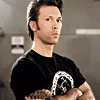 |
Zipping from heated houses to heated offices, most people avoid the outdoors during the Chicago winter. “I’d put myself in the camp of those who hibernate indoors,” says Shane Tritsch, who edited this month’s Cold Play, a portfolio of fun and invigorating winter activities. Tritsch, Chicago’s managing editor, previously lacked both ideas and enthusiasm, but he says this year promises cross-country skiing, hiking, and meteor showers. For balance, the article features recuperative indoor ideas, too. “Just as the existence of evil helps us to appreciate good, so does some numbing cold outdoors help us to appreciate a cup of hot chocolate or a crackling fire after we’ve come in,” Tritsch says.
 |
For Arena’s gift guide, MICHAEL BOONE photographed dozens of objects, each of which required particular attention. Even though he gets the instant feedback that comes with digital pictures, Boone says the process is painstaking. “I think people don’t understand the time involved,” he says. “They think, [Photographers] throw up a camera, they shoot, they’re done.” Digital cameras may have caused people to misperceive the art as easy, but they have also democratized the field, as have previous technological advances in photography. “I remember my mom with her [Kodak Brownie] Hawkeye, rubbing the flashbulb on her pants,” Boone says. “Everybody became a photographer back then.”
As the economy went south, ROBERT SHAROFF could find scarcely any architecture stories to write about. “I came to realize that the larger story is the lack of work at the moment,” he says. This month, he takes a hard look at the recession’s impact on the profession in the Business column “Shaking the Foundation.” Previous downturns haven’t had the suddenness of this one. “There hasn’t been this falling-off-a-cliff feeling [before],” Sharoff says. “Construction went from full blast to total halt within the space of a couple weeks.” Sharoff and his partner, William Zbaren, are currently finishing a book on St. Louis architecture.
GEOFFREY JOHNSON had no trouble amassing the source materials for The True Story of the Deadly Encounter at Fort Dearborn, his story on the event formerly known as the Fort Dearborn Massacre. “They were all on my bookshelf at home,” he says, adding that his personal interest took him many times to the South Loop site of the event, recently christened Battle of Fort Dearborn Park. He pored over several versions of the battle, going back through history to Juliette Kinzie’s seminal account. Johnson notes a metaphorical connection between standing on the shoulders of Kinzie and the location of his office desk many floors above her family’s ancestral land. “Here I was writing in the Kinzie Addition,” he says.
 |
“I teach, usually, a bunch of boys,” says CHAUNCEY HOLLINGSWORTH, who has courses in game design and the history of games at DePaul University. “I teach them about where games come from. They’re not just idle pastimes; they’re a real, living, breathing part of our culture, no less than the art we consume and make.” For “Power Up” in this month’s Arena, Hollingsworth wrote about Disney’s acquisition of the local video-game company Wideload, which will continue to be based here. “For Chicago it’s a great thing any time we can retain any creative brains and energy,” he says. Hollingsworth also runs a web and game design company called Zephyr Syndicate.
Photography: (Tritsch) Megan Lovejoy, (Hollingsworth) Chris Eichenseer Photography Hair: Dennis Lafferty/Grö, (Boone) courtesy Michael Boone



